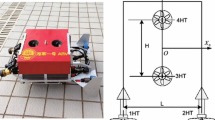Abstract
This paper describes the best choice to fuzzy implication operator and α-cut that are proper to the heuristic search technique for real-time collision avoidance of autonomous underwater vehicles (AUVs). A fuzzy implication operator is applied to the computation of fuzzy triangle product that constructs a new fuzzy relation between two fuzzy relations. An α-cut transforms a fuzzy relation into a crisp relation which is represented as a matrix. Those are the theoretical basis of heuristic search technique. In this paper, we review briefly our previous work—a heuristic search technique using fuzzy relational products for the collision avoidance system of AUVs, and propose the selection of a fuzzy implication operator and α-cut which are the most suitable for the search technique. In order to verify the optimality and the efficiency of the selected fuzzy implication operator and α-cut, we simulate every case of α-cut for each fuzzy implication operator in view of the cost of path and the number of α -cut generating acceptable path to the goal.
Similar content being viewed by others
References
Baldwin JF (1978) Fuzzy logic and approximate reasoning for mixed input arguments. Report No. EM/FS 4
Baldwin JF, Guild NCF (1978) Feasible algorithms for approximate reasoning using a fuzzy logic. Report No. EM/FS 8
Baldwin JF, Pilsworth BW (1978) Axiomatic approach to implication for approximate reasoning using a fuzzy logic. Report No. EC/FS 9
Baldwin JF, Guild NCF, Pilsworth BW (1978) Improved logic for fuzzy controller. Report No. EM/FS 5
Bandler W, Kohout LJ (1978a) Fuzzy relational products and fuzzy implication operators. Report No. FRP-1
Bandler W, Kohout LJ (1978b) Application of fuzzy logics to computer protection structures. Report No. FRP-3
Bandler W, Kohout LJ (1979) Fuzzy power sets and fuzzy implication operators. Report No. FRP-7, Department of Maths., University of Essex, Colchester
Bandler W, Kohout LJ (1980a) Fuzzy relational products as a tool for analysis and synthesis of the behaviour of complex natural and artificial system. In: Wang SK, Chang PP(eds) Fuzzy sets: theory and application to analysis and information systems. Plenum Press, New York, pp 341–367
Bandler W, Kohout LJ (1980b) Semantics of implication operators and fuzzy relational products. Int J Man Mach Stud 12(1): 89–115
Bandler W, Kohout LJ (1980c) Fuzzy power sets and fuzzy implication operator. Fuzzy Set Syst 4: 13–30
Bernard K, Robert CB, Sharon R (1996) Discrete mathematical structures, 3rd edn. Prentice Hall, Englewood Cliffs, pp 230–233
Kohout L (2001) Boolean and fuzzy relations. In: Pardalos PM, Floudas CA(eds) The encyclopedia of optimization. Kluwer, Dordrecht, pp 189–202
Kohout L, Harris M (1993) Computer representation of fuzzy and crisp relations by means of threaded trees using foresets and aftersets. J Fuzzy Logic Intell Syst 3(1)
Kohout LJ, Kim E (2002) The role of BK-products of relations in soft computing. Soft Comput 6(2): 87–91
Kohout LJ, Keravnou E, Bandler W (1984) Automatic documentary information retrieval by means of fuzzy relational products. In: Gaines BR, Zadeh LA, Zimmermann HJ(eds) Fuzzy sets in decision analysis. North-Holland, Amsterdam, pp 308–404
Lee YI, Noe CS, Kim YG (2002) Implication operators in fuzzy relational products for a local path-planning of AUVs. NAFIPS-FLINT, pp 221–226
Lee YI, Kim YG, Kohout LJ (2004) An intelligent collision avoidance system for AUVs using fuzzy relational products. Inf Sci 158: 209–232
Lozano PT, Wesley MA (1979) An algorithm for planning collision free paths among polyhedral obstacles. Commun ACM 22(10): 560–570
Ong SM (1990) A mission planning knowledge-based system with three-dimensional path optimization for the NPS model 2 autonomous underwater vehicle. Master’s Thesis, Naval Postgraduate School
Rescher N (1969) Many-valued logic. McGraw-Hill, New York
Sembi BS, Mamdani EH (1979) On the nature of implication in fuzzy logic. In: Proceeding of the ninth international symposium on multiple-valued logic, pp 143–151
Willmott R (1978) Two fuzzier implication operators in the theory of fuzzy power sets. Report No. FRP-2, Department of Maths., University of Essex, Colchester
Zadeh LA (1973) Outline of a new approach to the analysis of complex systems and decision process. IEEE Trans Syst Man Cybern, pp 28–44
Zimmermann HJ (1985) Fuzzy set theory and its applications. Kluwer/Nijhoff, Dordrecht/The Hague
Author information
Authors and Affiliations
Corresponding author
Additional information
This work was supported by the Korea Research Foundation Grant funded by the Korean Government (MOEHRD) (KRF-2007-521-D00433).
Rights and permissions
About this article
Cite this article
Lee, Yi., Kim, YG. Comparison of fuzzy implication operators by means of fuzzy relational products used for intelligent local path-planning of AUVs. Soft Comput 13, 535–549 (2009). https://doi.org/10.1007/s00500-008-0314-z
Published:
Issue Date:
DOI: https://doi.org/10.1007/s00500-008-0314-z




